Case Study Analysis: Health Economics of BMI Screening Program
VerifiedAdded on 2022/11/16
|21
|3896
|356
Case Study
AI Summary
This case study analyzes the health economics of BMI screening programs in public schools, focusing on the increasing prevalence of childhood obesity. It explores the implementation of BMI and eating disorder (ED) screening programs, discussing their potential benefits, including early identification and treatment of obesity and disordered eating, and their associated costs, such as screening-related expenses, medical care, and non-health costs. The study presents tables with cost estimations, QALY calculations, and prevalence data, using secondary sources to conduct a cost-effectiveness analysis. It highlights the importance of early intervention to reduce the health and economic burden of obesity, and provides recommendations for governmental improvements to BMI screening programs. The analysis considers health equity, feasibility, stakeholder acceptability, and sustainability, ultimately evaluating the cost-effectiveness of BMI screening.

COVER PAGE
WORD COUNT
ASSESMENT-NUMBER
ASSESMENT WEIGHTAGE
DATE OF SUBMISSION
1
WORD COUNT
ASSESMENT-NUMBER
ASSESMENT WEIGHTAGE
DATE OF SUBMISSION
1
Paraphrase This Document
Need a fresh take? Get an instant paraphrase of this document with our AI Paraphraser
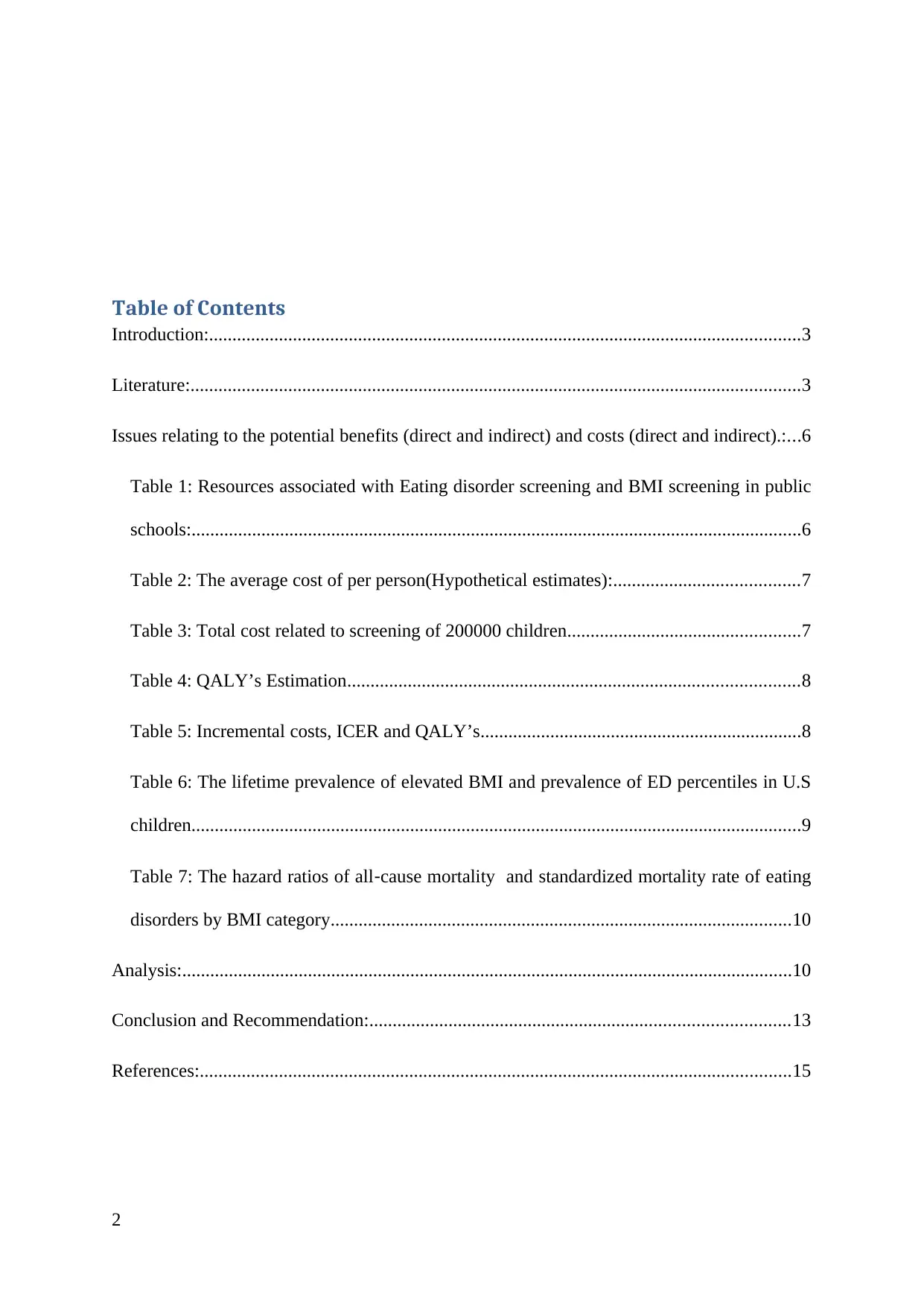
Table of Contents
Introduction:...............................................................................................................................3
Literature:...................................................................................................................................3
Issues relating to the potential benefits (direct and indirect) and costs (direct and indirect).:...6
Table 1: Resources associated with Eating disorder screening and BMI screening in public
schools:...................................................................................................................................6
Table 2: The average cost of per person(Hypothetical estimates):........................................7
Table 3: Total cost related to screening of 200000 children..................................................7
Table 4: QALY’s Estimation.................................................................................................8
Table 5: Incremental costs, ICER and QALY’s.....................................................................8
Table 6: The lifetime prevalence of elevated BMI and prevalence of ED percentiles in U.S
children...................................................................................................................................9
Table 7: The hazard ratios of all‐cause mortality and standardized mortality rate of eating
disorders by BMI category...................................................................................................10
Analysis:...................................................................................................................................10
Conclusion and Recommendation:..........................................................................................13
References:...............................................................................................................................15
2
Introduction:...............................................................................................................................3
Literature:...................................................................................................................................3
Issues relating to the potential benefits (direct and indirect) and costs (direct and indirect).:...6
Table 1: Resources associated with Eating disorder screening and BMI screening in public
schools:...................................................................................................................................6
Table 2: The average cost of per person(Hypothetical estimates):........................................7
Table 3: Total cost related to screening of 200000 children..................................................7
Table 4: QALY’s Estimation.................................................................................................8
Table 5: Incremental costs, ICER and QALY’s.....................................................................8
Table 6: The lifetime prevalence of elevated BMI and prevalence of ED percentiles in U.S
children...................................................................................................................................9
Table 7: The hazard ratios of all‐cause mortality and standardized mortality rate of eating
disorders by BMI category...................................................................................................10
Analysis:...................................................................................................................................10
Conclusion and Recommendation:..........................................................................................13
References:...............................................................................................................................15
2

3
⊘ This is a preview!⊘
Do you want full access?
Subscribe today to unlock all pages.

Trusted by 1+ million students worldwide
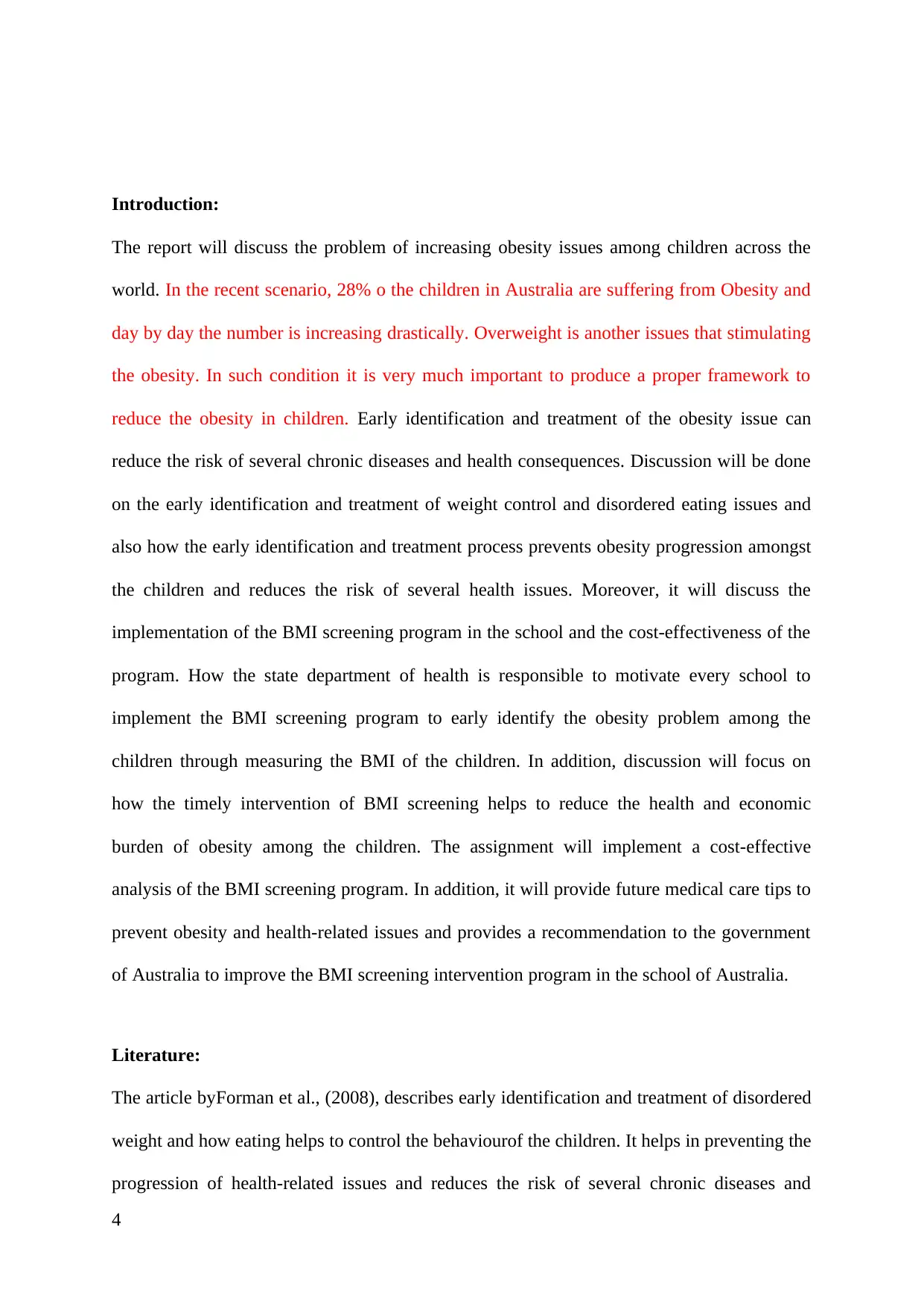
Introduction:
The report will discuss the problem of increasing obesity issues among children across the
world. In the recent scenario, 28% o the children in Australia are suffering from Obesity and
day by day the number is increasing drastically. Overweight is another issues that stimulating
the obesity. In such condition it is very much important to produce a proper framework to
reduce the obesity in children. Early identification and treatment of the obesity issue can
reduce the risk of several chronic diseases and health consequences. Discussion will be done
on the early identification and treatment of weight control and disordered eating issues and
also how the early identification and treatment process prevents obesity progression amongst
the children and reduces the risk of several health issues. Moreover, it will discuss the
implementation of the BMI screening program in the school and the cost-effectiveness of the
program. How the state department of health is responsible to motivate every school to
implement the BMI screening program to early identify the obesity problem among the
children through measuring the BMI of the children. In addition, discussion will focus on
how the timely intervention of BMI screening helps to reduce the health and economic
burden of obesity among the children. The assignment will implement a cost-effective
analysis of the BMI screening program. In addition, it will provide future medical care tips to
prevent obesity and health-related issues and provides a recommendation to the government
of Australia to improve the BMI screening intervention program in the school of Australia.
Literature:
The article byForman et al., (2008), describes early identification and treatment of disordered
weight and how eating helps to control the behaviourof the children. It helps in preventing the
progression of health-related issues and reduces the risk of several chronic diseases and
4
The report will discuss the problem of increasing obesity issues among children across the
world. In the recent scenario, 28% o the children in Australia are suffering from Obesity and
day by day the number is increasing drastically. Overweight is another issues that stimulating
the obesity. In such condition it is very much important to produce a proper framework to
reduce the obesity in children. Early identification and treatment of the obesity issue can
reduce the risk of several chronic diseases and health consequences. Discussion will be done
on the early identification and treatment of weight control and disordered eating issues and
also how the early identification and treatment process prevents obesity progression amongst
the children and reduces the risk of several health issues. Moreover, it will discuss the
implementation of the BMI screening program in the school and the cost-effectiveness of the
program. How the state department of health is responsible to motivate every school to
implement the BMI screening program to early identify the obesity problem among the
children through measuring the BMI of the children. In addition, discussion will focus on
how the timely intervention of BMI screening helps to reduce the health and economic
burden of obesity among the children. The assignment will implement a cost-effective
analysis of the BMI screening program. In addition, it will provide future medical care tips to
prevent obesity and health-related issues and provides a recommendation to the government
of Australia to improve the BMI screening intervention program in the school of Australia.
Literature:
The article byForman et al., (2008), describes early identification and treatment of disordered
weight and how eating helps to control the behaviourof the children. It helps in preventing the
progression of health-related issues and reduces the risk of several chronic diseases and
4
Paraphrase This Document
Need a fresh take? Get an instant paraphrase of this document with our AI Paraphraser

health consequences (Forman et al., 2008). In this article, national eating screening program
was first organized in the high schools across the United States. The national eating screening
program is held in the high school for identifying the eating disorder issues among the
children. The researchers found that 1 in 10 boys and 1 in 4 girls have 1 disorder weight or
eating control symptom (Eatingdisorders.org.au, 2019).
5
was first organized in the high schools across the United States. The national eating screening
program is held in the high school for identifying the eating disorder issues among the
children. The researchers found that 1 in 10 boys and 1 in 4 girls have 1 disorder weight or
eating control symptom (Eatingdisorders.org.au, 2019).
5
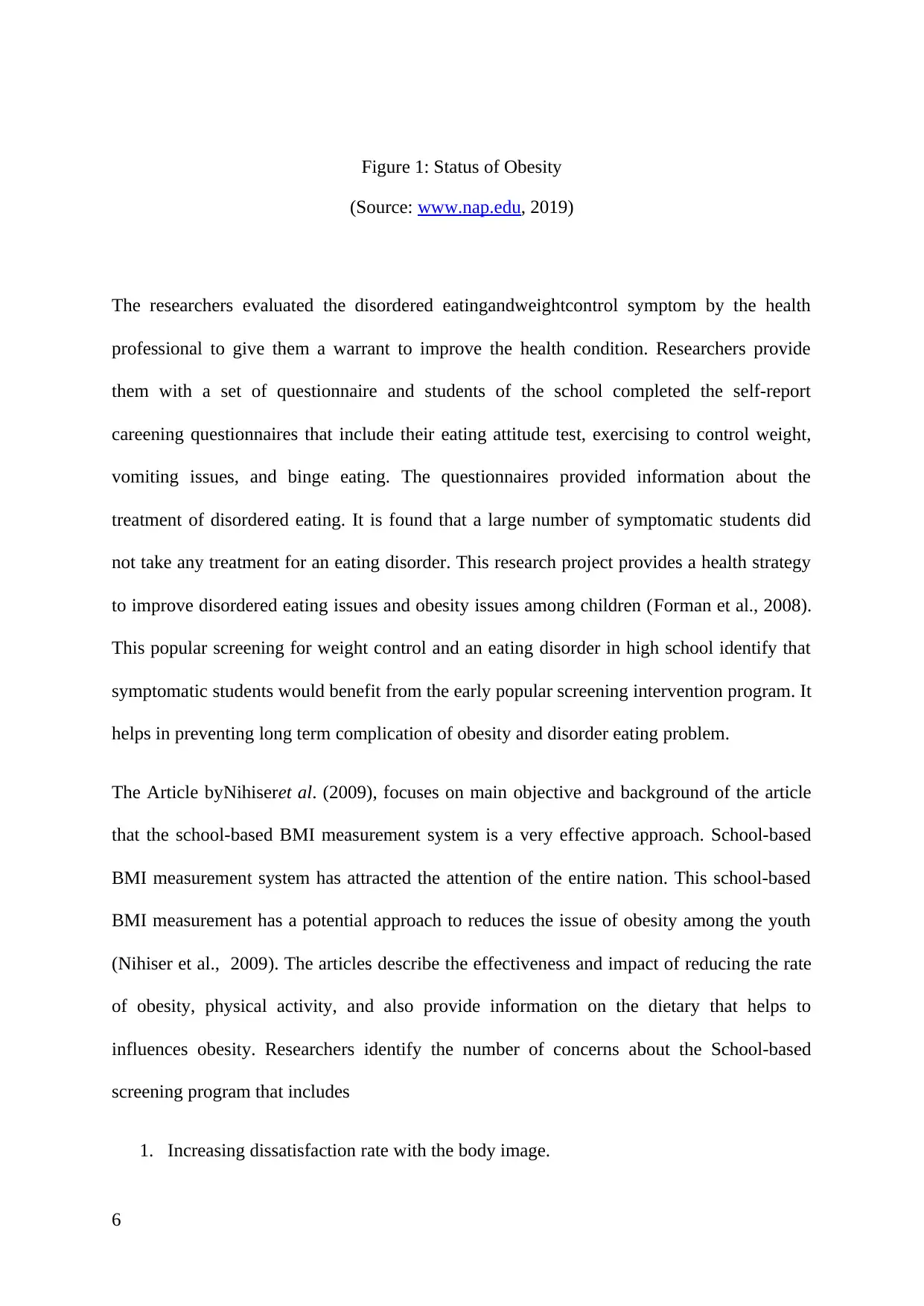
Figure 1: Status of Obesity
(Source: www.nap.edu, 2019)
The researchers evaluated the disordered eatingandweightcontrol symptom by the health
professional to give them a warrant to improve the health condition. Researchers provide
them with a set of questionnaire and students of the school completed the self-report
careening questionnaires that include their eating attitude test, exercising to control weight,
vomiting issues, and binge eating. The questionnaires provided information about the
treatment of disordered eating. It is found that a large number of symptomatic students did
not take any treatment for an eating disorder. This research project provides a health strategy
to improve disordered eating issues and obesity issues among children (Forman et al., 2008).
This popular screening for weight control and an eating disorder in high school identify that
symptomatic students would benefit from the early popular screening intervention program. It
helps in preventing long term complication of obesity and disorder eating problem.
The Article byNihiseret al. (2009), focuses on main objective and background of the article
that the school-based BMI measurement system is a very effective approach. School-based
BMI measurement system has attracted the attention of the entire nation. This school-based
BMI measurement has a potential approach to reduces the issue of obesity among the youth
(Nihiser et al., 2009). The articles describe the effectiveness and impact of reducing the rate
of obesity, physical activity, and also provide information on the dietary that helps to
influences obesity. Researchers identify the number of concerns about the School-based
screening program that includes
1. Increasing dissatisfaction rate with the body image.
6
(Source: www.nap.edu, 2019)
The researchers evaluated the disordered eatingandweightcontrol symptom by the health
professional to give them a warrant to improve the health condition. Researchers provide
them with a set of questionnaire and students of the school completed the self-report
careening questionnaires that include their eating attitude test, exercising to control weight,
vomiting issues, and binge eating. The questionnaires provided information about the
treatment of disordered eating. It is found that a large number of symptomatic students did
not take any treatment for an eating disorder. This research project provides a health strategy
to improve disordered eating issues and obesity issues among children (Forman et al., 2008).
This popular screening for weight control and an eating disorder in high school identify that
symptomatic students would benefit from the early popular screening intervention program. It
helps in preventing long term complication of obesity and disorder eating problem.
The Article byNihiseret al. (2009), focuses on main objective and background of the article
that the school-based BMI measurement system is a very effective approach. School-based
BMI measurement system has attracted the attention of the entire nation. This school-based
BMI measurement has a potential approach to reduces the issue of obesity among the youth
(Nihiser et al., 2009). The articles describe the effectiveness and impact of reducing the rate
of obesity, physical activity, and also provide information on the dietary that helps to
influences obesity. Researchers identify the number of concerns about the School-based
screening program that includes
1. Increasing dissatisfaction rate with the body image.
6
⊘ This is a preview!⊘
Do you want full access?
Subscribe today to unlock all pages.

Trusted by 1+ million students worldwide
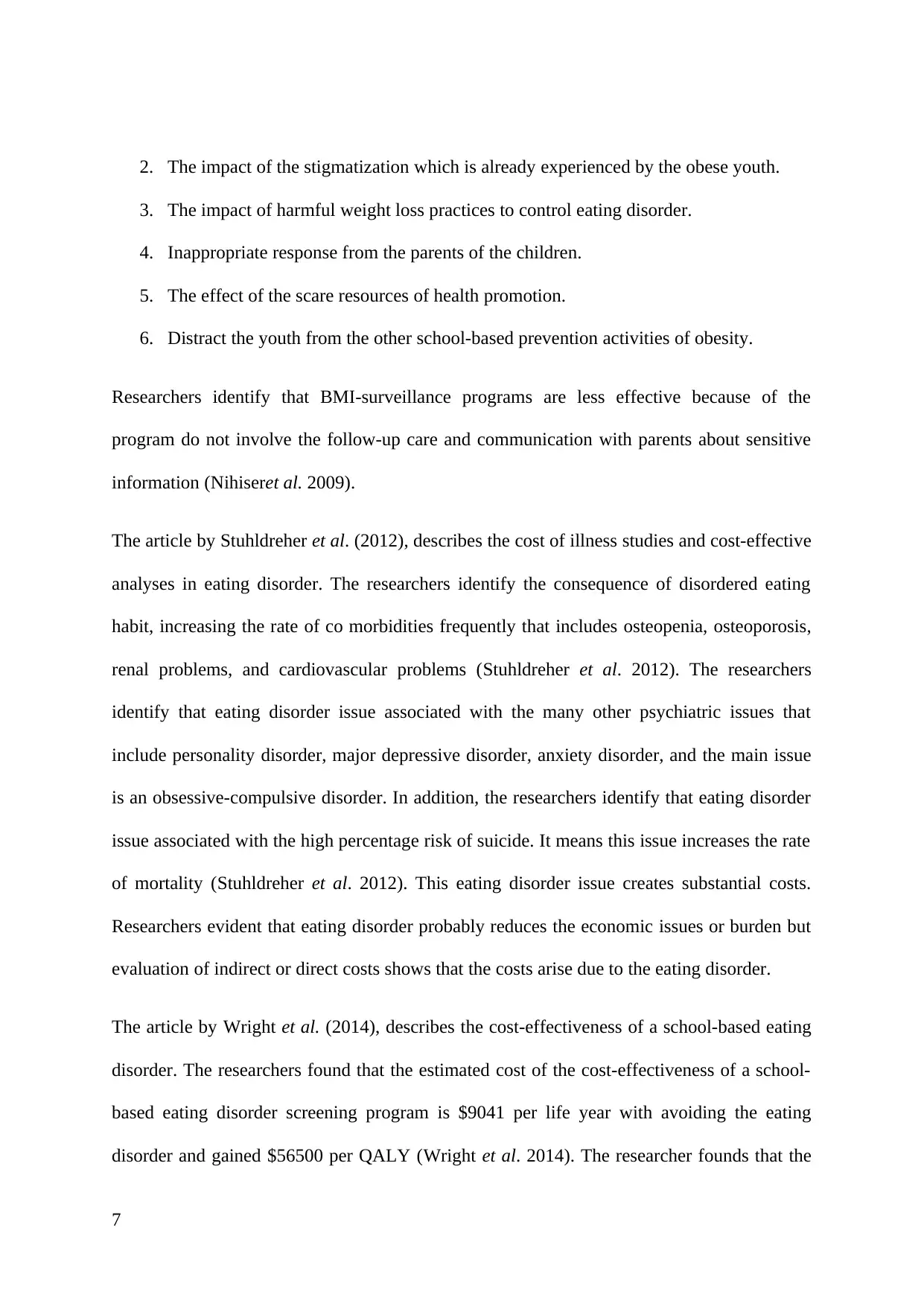
2. The impact of the stigmatization which is already experienced by the obese youth.
3. The impact of harmful weight loss practices to control eating disorder.
4. Inappropriate response from the parents of the children.
5. The effect of the scare resources of health promotion.
6. Distract the youth from the other school-based prevention activities of obesity.
Researchers identify that BMI-surveillance programs are less effective because of the
program do not involve the follow-up care and communication with parents about sensitive
information (Nihiseret al. 2009).
The article by Stuhldreher et al. (2012), describes the cost of illness studies and cost-effective
analyses in eating disorder. The researchers identify the consequence of disordered eating
habit, increasing the rate of co morbidities frequently that includes osteopenia, osteoporosis,
renal problems, and cardiovascular problems (Stuhldreher et al. 2012). The researchers
identify that eating disorder issue associated with the many other psychiatric issues that
include personality disorder, major depressive disorder, anxiety disorder, and the main issue
is an obsessive-compulsive disorder. In addition, the researchers identify that eating disorder
issue associated with the high percentage risk of suicide. It means this issue increases the rate
of mortality (Stuhldreher et al. 2012). This eating disorder issue creates substantial costs.
Researchers evident that eating disorder probably reduces the economic issues or burden but
evaluation of indirect or direct costs shows that the costs arise due to the eating disorder.
The article by Wright et al. (2014), describes the cost-effectiveness of a school-based eating
disorder. The researchers found that the estimated cost of the cost-effectiveness of a school-
based eating disorder screening program is $9041 per life year with avoiding the eating
disorder and gained $56500 per QALY (Wright et al. 2014). The researcher founds that the
7
3. The impact of harmful weight loss practices to control eating disorder.
4. Inappropriate response from the parents of the children.
5. The effect of the scare resources of health promotion.
6. Distract the youth from the other school-based prevention activities of obesity.
Researchers identify that BMI-surveillance programs are less effective because of the
program do not involve the follow-up care and communication with parents about sensitive
information (Nihiseret al. 2009).
The article by Stuhldreher et al. (2012), describes the cost of illness studies and cost-effective
analyses in eating disorder. The researchers identify the consequence of disordered eating
habit, increasing the rate of co morbidities frequently that includes osteopenia, osteoporosis,
renal problems, and cardiovascular problems (Stuhldreher et al. 2012). The researchers
identify that eating disorder issue associated with the many other psychiatric issues that
include personality disorder, major depressive disorder, anxiety disorder, and the main issue
is an obsessive-compulsive disorder. In addition, the researchers identify that eating disorder
issue associated with the high percentage risk of suicide. It means this issue increases the rate
of mortality (Stuhldreher et al. 2012). This eating disorder issue creates substantial costs.
Researchers evident that eating disorder probably reduces the economic issues or burden but
evaluation of indirect or direct costs shows that the costs arise due to the eating disorder.
The article by Wright et al. (2014), describes the cost-effectiveness of a school-based eating
disorder. The researchers found that the estimated cost of the cost-effectiveness of a school-
based eating disorder screening program is $9041 per life year with avoiding the eating
disorder and gained $56500 per QALY (Wright et al. 2014). The researcher founds that the
7
Paraphrase This Document
Need a fresh take? Get an instant paraphrase of this document with our AI Paraphraser
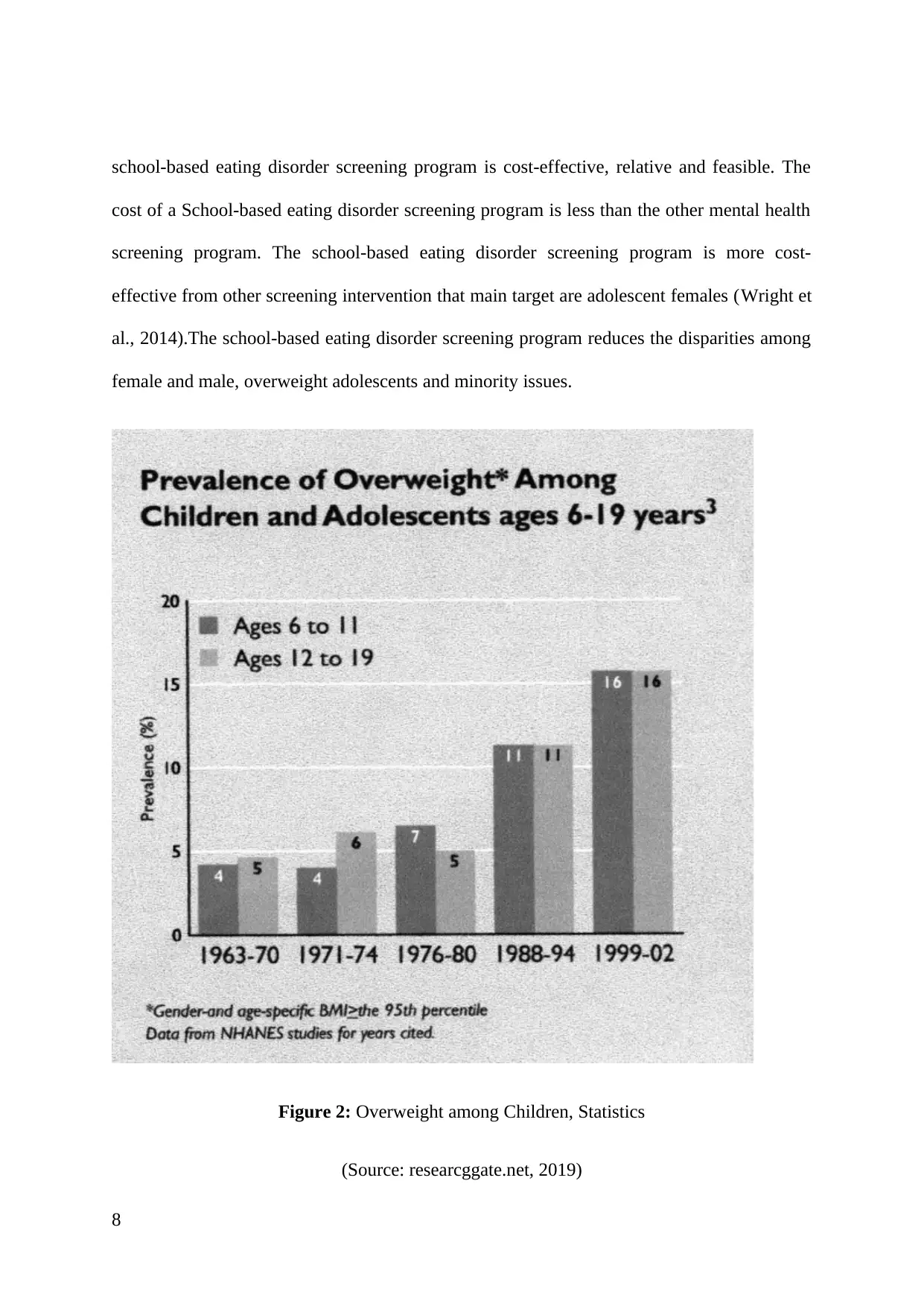
school-based eating disorder screening program is cost-effective, relative and feasible. The
cost of a School-based eating disorder screening program is less than the other mental health
screening program. The school-based eating disorder screening program is more cost-
effective from other screening intervention that main target are adolescent females (Wright et
al., 2014).The school-based eating disorder screening program reduces the disparities among
female and male, overweight adolescents and minority issues.
Figure 2: Overweight among Children, Statistics
(Source: researcggate.net, 2019)
8
cost of a School-based eating disorder screening program is less than the other mental health
screening program. The school-based eating disorder screening program is more cost-
effective from other screening intervention that main target are adolescent females (Wright et
al., 2014).The school-based eating disorder screening program reduces the disparities among
female and male, overweight adolescents and minority issues.
Figure 2: Overweight among Children, Statistics
(Source: researcggate.net, 2019)
8
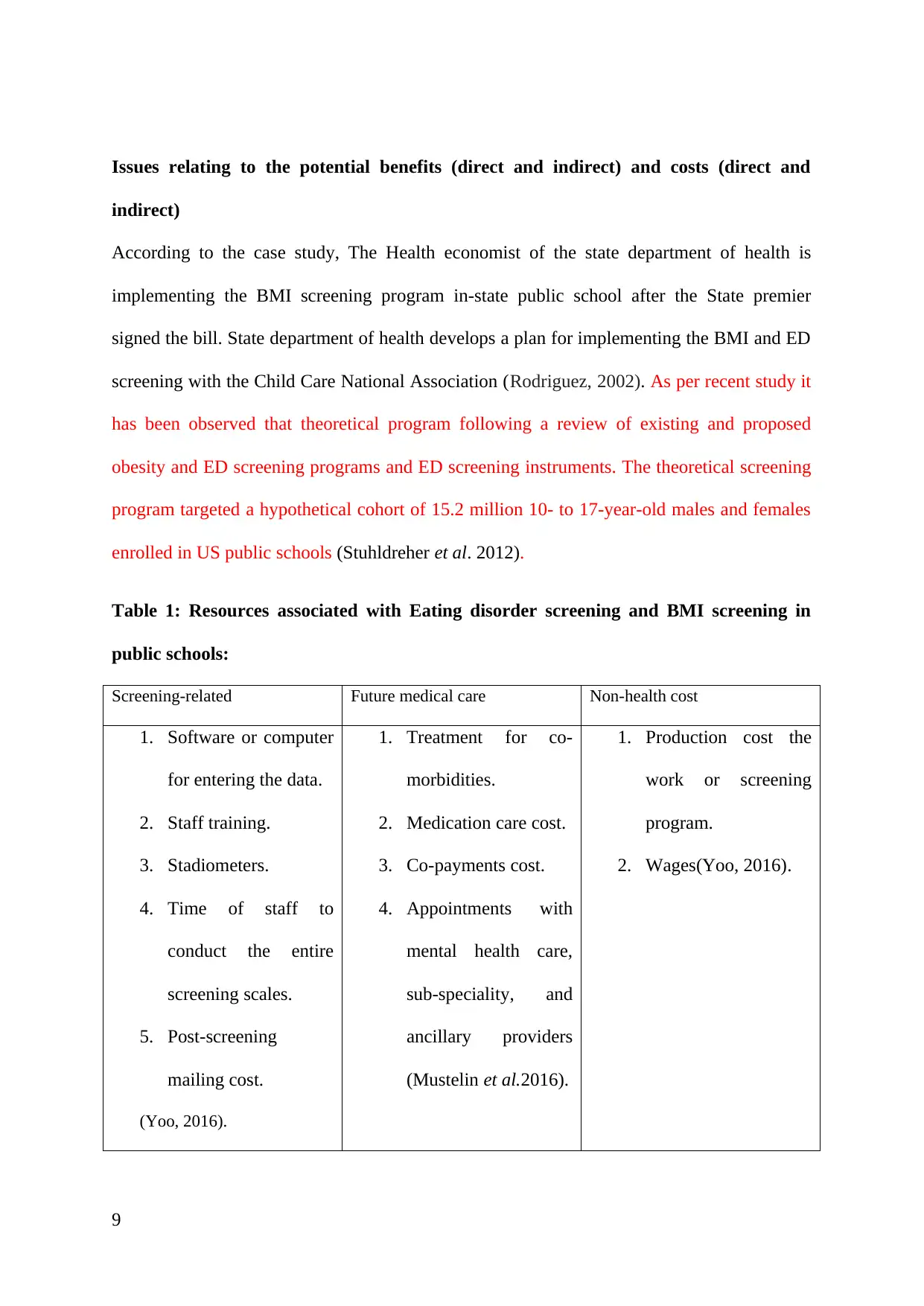
Issues relating to the potential benefits (direct and indirect) and costs (direct and
indirect)
According to the case study, The Health economist of the state department of health is
implementing the BMI screening program in-state public school after the State premier
signed the bill. State department of health develops a plan for implementing the BMI and ED
screening with the Child Care National Association (Rodriguez, 2002). As per recent study it
has been observed that theoretical program following a review of existing and proposed
obesity and ED screening programs and ED screening instruments. The theoretical screening
program targeted a hypothetical cohort of 15.2 million 10- to 17-year-old males and females
enrolled in US public schools (Stuhldreher et al. 2012).
Table 1: Resources associated with Eating disorder screening and BMI screening in
public schools:
Screening-related Future medical care Non-health cost
1. Software or computer
for entering the data.
2. Staff training.
3. Stadiometers.
4. Time of staff to
conduct the entire
screening scales.
5. Post-screening
mailing cost.
(Yoo, 2016).
1. Treatment for co-
morbidities.
2. Medication care cost.
3. Co-payments cost.
4. Appointments with
mental health care,
sub-speciality, and
ancillary providers
(Mustelin et al.2016).
1. Production cost the
work or screening
program.
2. Wages(Yoo, 2016).
9
indirect)
According to the case study, The Health economist of the state department of health is
implementing the BMI screening program in-state public school after the State premier
signed the bill. State department of health develops a plan for implementing the BMI and ED
screening with the Child Care National Association (Rodriguez, 2002). As per recent study it
has been observed that theoretical program following a review of existing and proposed
obesity and ED screening programs and ED screening instruments. The theoretical screening
program targeted a hypothetical cohort of 15.2 million 10- to 17-year-old males and females
enrolled in US public schools (Stuhldreher et al. 2012).
Table 1: Resources associated with Eating disorder screening and BMI screening in
public schools:
Screening-related Future medical care Non-health cost
1. Software or computer
for entering the data.
2. Staff training.
3. Stadiometers.
4. Time of staff to
conduct the entire
screening scales.
5. Post-screening
mailing cost.
(Yoo, 2016).
1. Treatment for co-
morbidities.
2. Medication care cost.
3. Co-payments cost.
4. Appointments with
mental health care,
sub-speciality, and
ancillary providers
(Mustelin et al.2016).
1. Production cost the
work or screening
program.
2. Wages(Yoo, 2016).
9
⊘ This is a preview!⊘
Do you want full access?
Subscribe today to unlock all pages.

Trusted by 1+ million students worldwide
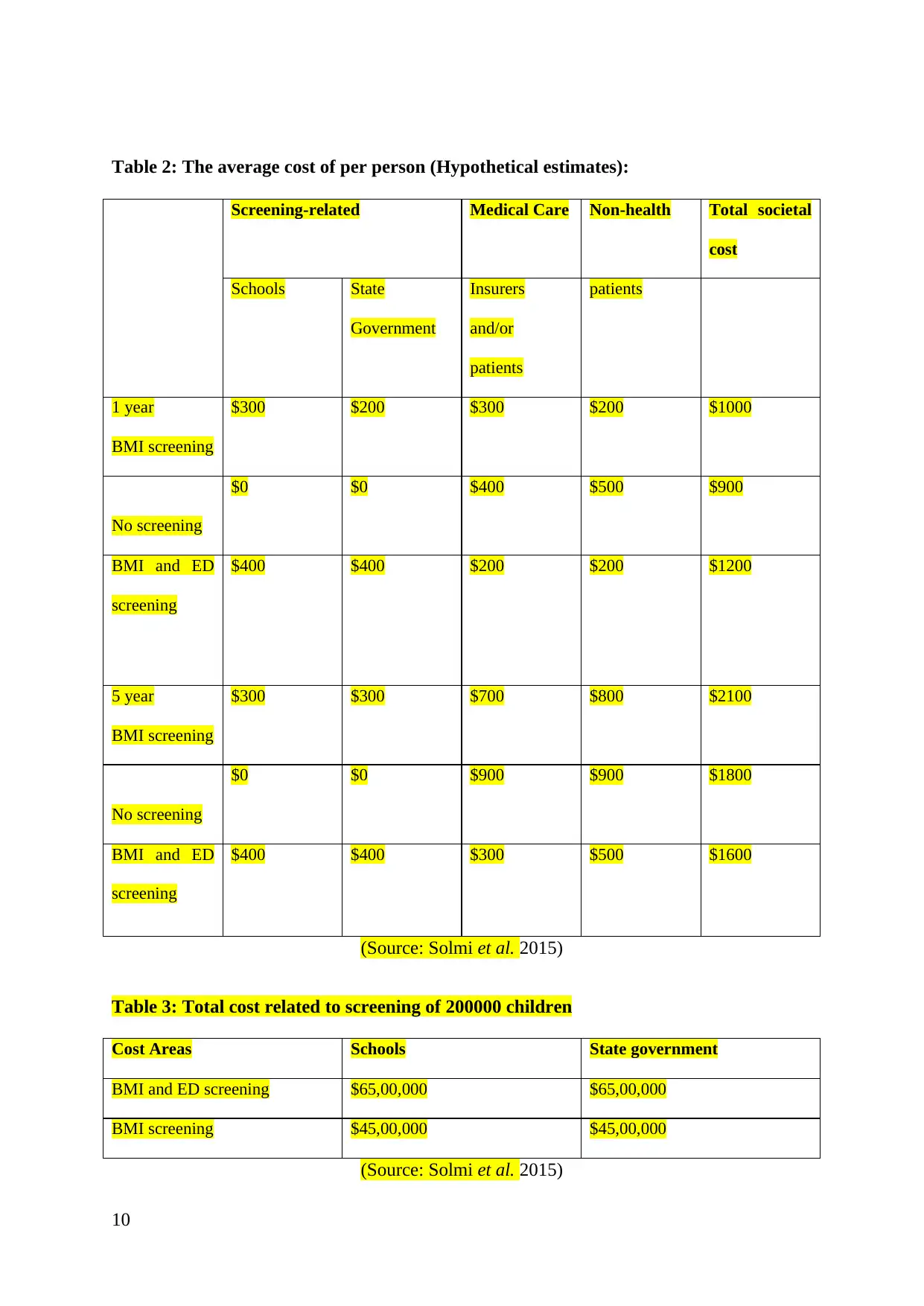
Table 2: The average cost of per person (Hypothetical estimates):
Screening-related Medical Care Non-health Total societal
cost
Schools State
Government
Insurers
and/or
patients
patients
1 year
BMI screening
$300 $200 $300 $200 $1000
No screening
$0 $0 $400 $500 $900
BMI and ED
screening
$400 $400 $200 $200 $1200
5 year
BMI screening
$300 $300 $700 $800 $2100
No screening
$0 $0 $900 $900 $1800
BMI and ED
screening
$400 $400 $300 $500 $1600
(Source: Solmi et al. 2015)
Table 3: Total cost related to screening of 200000 children
Cost Areas Schools State government
BMI and ED screening $65,00,000 $65,00,000
BMI screening $45,00,000 $45,00,000
(Source: Solmi et al. 2015)
10
Screening-related Medical Care Non-health Total societal
cost
Schools State
Government
Insurers
and/or
patients
patients
1 year
BMI screening
$300 $200 $300 $200 $1000
No screening
$0 $0 $400 $500 $900
BMI and ED
screening
$400 $400 $200 $200 $1200
5 year
BMI screening
$300 $300 $700 $800 $2100
No screening
$0 $0 $900 $900 $1800
BMI and ED
screening
$400 $400 $300 $500 $1600
(Source: Solmi et al. 2015)
Table 3: Total cost related to screening of 200000 children
Cost Areas Schools State government
BMI and ED screening $65,00,000 $65,00,000
BMI screening $45,00,000 $45,00,000
(Source: Solmi et al. 2015)
10
Paraphrase This Document
Need a fresh take? Get an instant paraphrase of this document with our AI Paraphraser
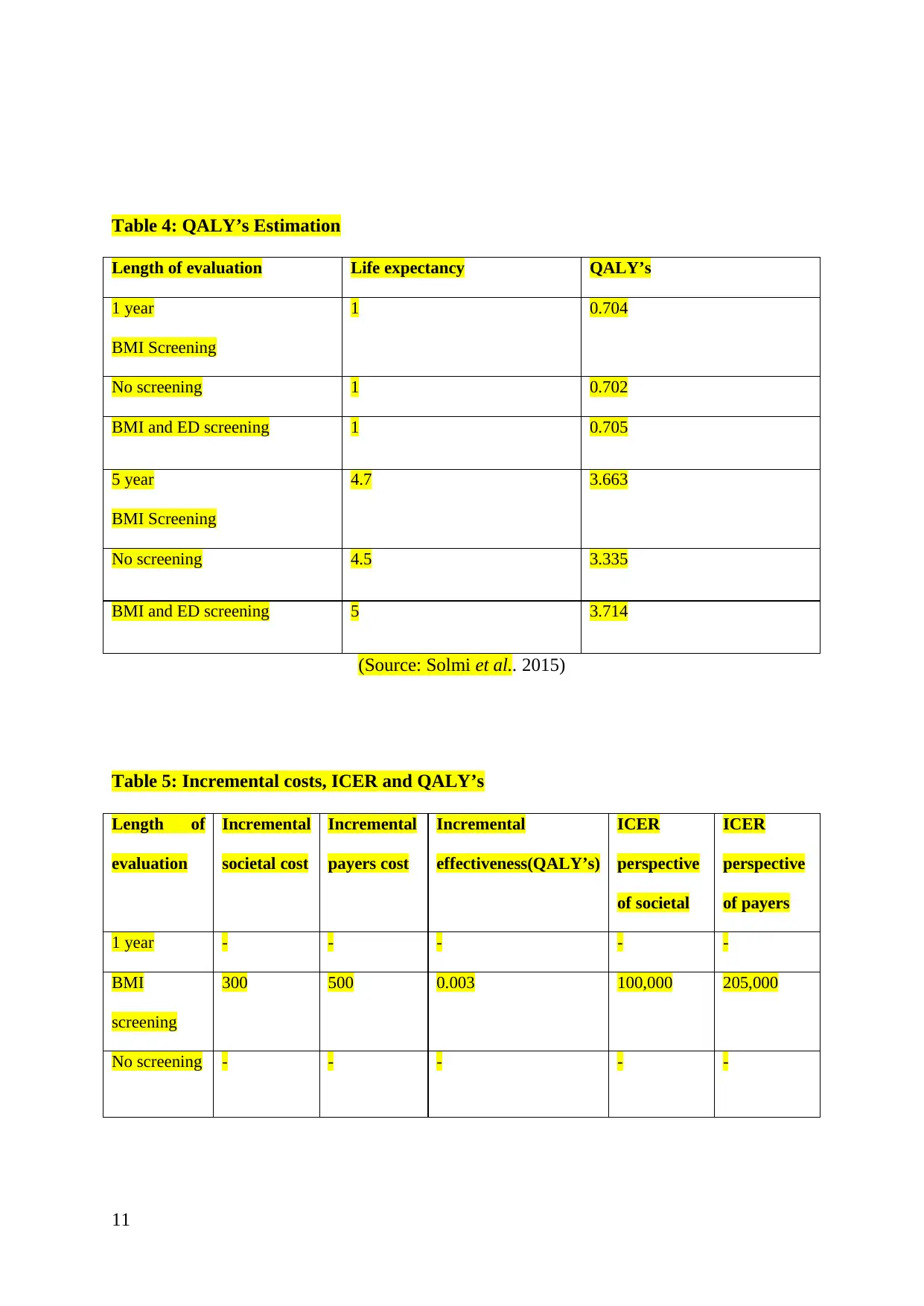
Table 4: QALY’s Estimation
Length of evaluation Life expectancy QALY’s
1 year
BMI Screening
1 0.704
No screening 1 0.702
BMI and ED screening 1 0.705
5 year
BMI Screening
4.7 3.663
No screening 4.5 3.335
BMI and ED screening 5 3.714
(Source: Solmi et al.. 2015)
Table 5: Incremental costs, ICER and QALY’s
Length of
evaluation
Incremental
societal cost
Incremental
payers cost
Incremental
effectiveness(QALY’s)
ICER
perspective
of societal
ICER
perspective
of payers
1 year - - - - -
BMI
screening
300 500 0.003 100,000 205,000
No screening - - - - -
11
Length of evaluation Life expectancy QALY’s
1 year
BMI Screening
1 0.704
No screening 1 0.702
BMI and ED screening 1 0.705
5 year
BMI Screening
4.7 3.663
No screening 4.5 3.335
BMI and ED screening 5 3.714
(Source: Solmi et al.. 2015)
Table 5: Incremental costs, ICER and QALY’s
Length of
evaluation
Incremental
societal cost
Incremental
payers cost
Incremental
effectiveness(QALY’s)
ICER
perspective
of societal
ICER
perspective
of payers
1 year - - - - -
BMI
screening
300 500 0.003 100,000 205,000
No screening - - - - -
11
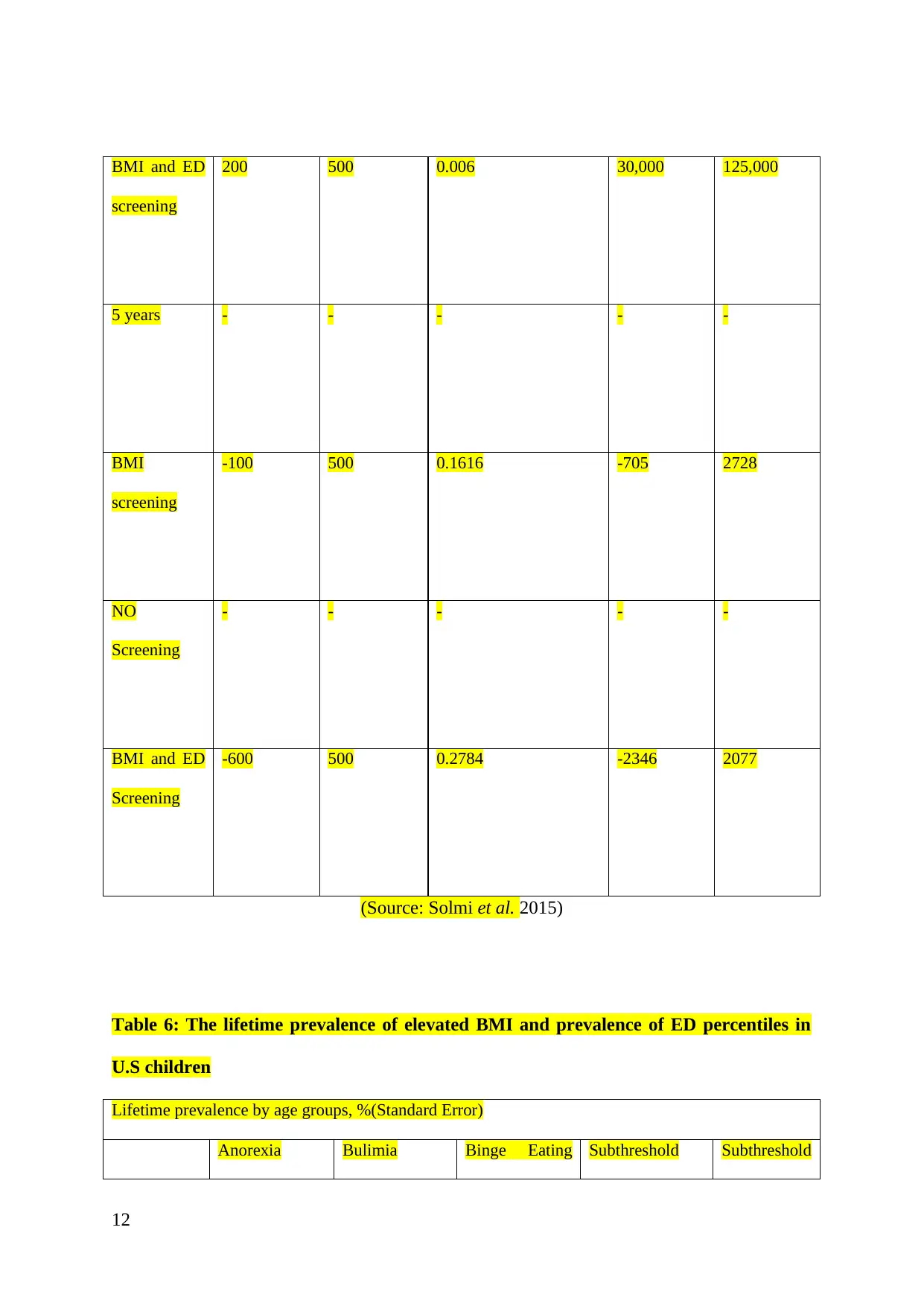
BMI and ED
screening
200 500 0.006 30,000 125,000
5 years - - - - -
BMI
screening
-100 500 0.1616 -705 2728
NO
Screening
- - - - -
BMI and ED
Screening
-600 500 0.2784 -2346 2077
(Source: Solmi et al. 2015)
Table 6: The lifetime prevalence of elevated BMI and prevalence of ED percentiles in
U.S children
Lifetime prevalence by age groups, %(Standard Error)
Anorexia Bulimia Binge Eating Subthreshold Subthreshold
12
screening
200 500 0.006 30,000 125,000
5 years - - - - -
BMI
screening
-100 500 0.1616 -705 2728
NO
Screening
- - - - -
BMI and ED
Screening
-600 500 0.2784 -2346 2077
(Source: Solmi et al. 2015)
Table 6: The lifetime prevalence of elevated BMI and prevalence of ED percentiles in
U.S children
Lifetime prevalence by age groups, %(Standard Error)
Anorexia Bulimia Binge Eating Subthreshold Subthreshold
12
⊘ This is a preview!⊘
Do you want full access?
Subscribe today to unlock all pages.

Trusted by 1+ million students worldwide
1 out of 21
Related Documents
Your All-in-One AI-Powered Toolkit for Academic Success.
+13062052269
info@desklib.com
Available 24*7 on WhatsApp / Email
![[object Object]](/_next/static/media/star-bottom.7253800d.svg)
Unlock your academic potential
Copyright © 2020–2025 A2Z Services. All Rights Reserved. Developed and managed by ZUCOL.





